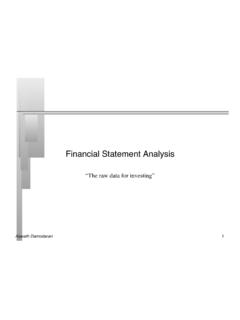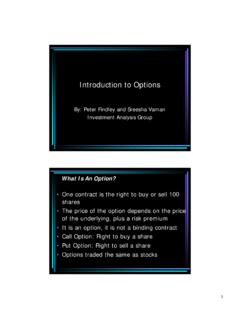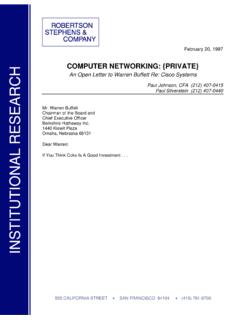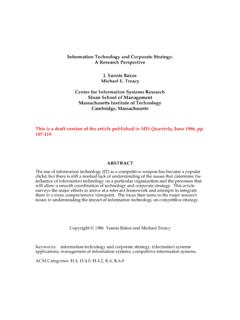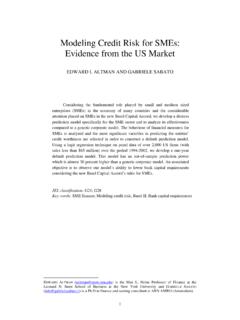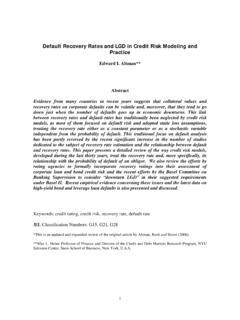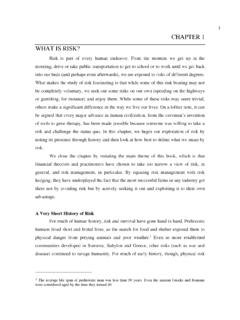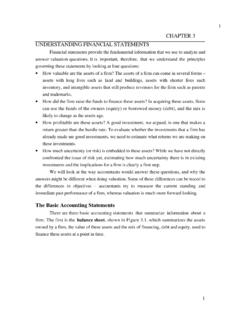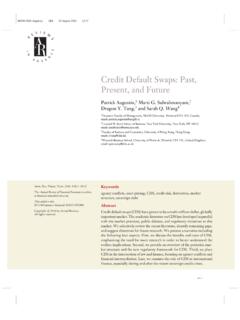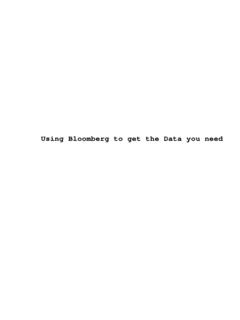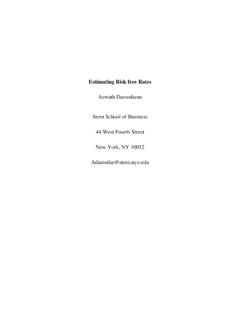Transcription of Return on Capital (ROC), Return on Invested Capital (ROIC ...
1 1 Return on Capital (ROC), Return on Invested Capital (ROIC) and Return on Equity (ROE): Measurement and Implications aswath damodaran Stern School of Business July 2007 2 ROC, ROIC and ROE: Measurement and Implications If there has been a shift in corporate finance and valuation in recent years, it has been towards giving excess returns a more central role in determining the value of a business. While early valuation models emphasized the relationship between growth and value higher growth firms were assigned higher values more recent iterations of these models have noted that growth unaccompanied by excess returns creates no value. With this shift towards excess returns has come an increased focus on measuring and forecasting returns earned by businesses on both investments made in the past and expected future investments. In this paper, we examine accounting and cash flow measures of these returns and how best to forecast these numbers for any given business for the future.
2 3 The notion that the value of a business is a function of its expected cash flows is deeply engrained in finance. To generate these cashflows, though, firms have to raise and invest Capital in assets and this Capital is not costless. In fact, it is only to the extent that the cash flows exceed the costs of raising Capital from both debt and equity that they create value for a business. In effect, the value of a business can be simply stated as a function of the excess returns that it generates from both existing and new investments. While this principle is intuitive and easily proved, measuring excess returns has proved to be difficult to do. On one side of the equation are the costs of debt, equity and Capital . While there are clearly significant questions that remain to be addressed, a significant portion of the research in finance has been directed towards estimating these numbers more precisely.
3 On the other side of the equation are the returns themselves and surprisingly little has been done in coming up with a cohesive and consistent measure of returns generated on investments and how these returns can be expected to evolve over time. In the first part of this paper, we will lay out what we are trying to measure with these returns and why it matters so much that we get a good estimate of the numbers. In the second part of the paper, we will look at both accounting and cash flow based measures of returns and the advantages and disadvantages of both. In the third part of the paper, we will consider factors that may cause the measured returns for a firm to deviate from its true returns and how best to fix the problems. In the fourth part of the chapter, we will turn our attention to forecasting investment returns and how best to incorporate the effects of competition into these forecasts.
4 investment Returns: What and Why? In finance and accounting, there are frequent references to returns on investments and different definitions of these returns. To better understand, what we are trying to measure with investment returns, consider a financial balance sheet in figure 1. 4 AssetsLiabilitiesInvestments alreadymadeDebtEquityBorrowed moneyOwner s fundsInvestments yet tobe madeAssets in PlaceExisting InvestmentsGenerate cashflows todayGrowth AssetsExpected Value that will be created by future investmentsFigure 1: A Financial Balance Sheet Note the contrast to an accounting balance sheet, which is more focused on categorizing assets based upon whether they are fixed, current or intangible and recording them at accounting or book value estimates of value. Note also the categorization of assets in this balance sheet into assets in place and growth assets, thus setting up the two basic questions to which we need answered in both corporate finance and valuation : a.
5 How good are the firm s existing investments? In other words, do they generate returns that exceed the cost of funding them? b. What do we expect the excess returns to look like on future investments? The answer to the first question lies in the past and will require us to focus on the Capital that the firm has Invested in assets in place and the earnings/cash flows it generates on these investments. In effect, this is what we are trying to do when we compute the Return on Invested Capital and compare it to the cost of Capital . To answer the second question, we may very well start with past returns but we cannot stop there. After all, the competitive environment and investment potential for the firm may have changed substantially and these changes have to be incorporated into the forecasts of future returns. In practical terms, this will require us to adjust past returns for changes or even replace them with new and different measures of Return for future investments.
6 The categorization of Capital into equity and debt also provides us with a simple way of differentiating between different ways of measuring returns. We can focus on just the equity Invested in projects and measure the Return on this equity investment ; this would then have to be compared to the cost of equity. Alternatively, we can measure the overall Return earned on call Capital (debt and equity) Invested in an investment ; this is the Return on Capital and can be compared to the cost of Capital . 5 Why are we so focused on measuring returns on past and future investments? The reason, as we noted in the introduction, is simple. A firm that generates higher returns on an investment than it costs it to raise Capital for that investment is earning excess returns and will trade at a premium over a firm that does not earn excess returns. Why separate the returns on existing investments from those on future investments?
7 A firm that expects to continue generating positive excess returns on new investments in the future will see its value increase as growth increases, whereas a firm that earns returns that do match up to its cost of funding will destroy value as it grows. The link between excess returns and value is now clearly established in valuation models. The link is explicit in excess Return models where the value of a firm is written as the sum of the values of the Capital Invested in the existing assets in the firm and the present value of all future excess returns on both existing assets and future investments. It is implicit in conventional discounted cash flow models but becomes a key component of value if expected growth is computed based upon fundamentals. For instance, the sustainable growth rate in equity valuation models is the product of the expected Return on equity on new investments and the proportion of earnings held back in the firm (retention ratio).
8 In firm valuation models, the expected growth rate is a product of the Return on Capital Invested in new assets and the proportion of operating income reinvested back into the business (reinvestment rate): Table 1: Sustainable Growth Rates and Reinvestment Assumptions How much did you reinvest? How well did you reinvest? Operating Income Reinvestment Rate = (Cap Ex - Deprec'n + WC)EBIT(1-t) X Return on Invested Capital Net Income Equity Reinvestment Rate = (Cap Ex - Deprec'n + WC - Debt)Net Income X Non-cash Return on Equity Earnings per share Retention Ratio = 1 DividendsNet Income X Return on Equity With this link between growth and Return quality, we are in effect looking at the trade off in investing. Reinvesting more will increase the growth rate but it will increase value 6 only if the returns earned on the investments exceed their costs. Even the growth that can be attributed to using existing assets more efficiently can be stated in terms of changes in returns on equity and Table 2: Efficiency Growth and Return Assumptions Efficiency Growth in period t Operating Income Return on Capitalt, Existing Assets Return on Capitalt-1, Existing AssetsReturn on Capitalt-1, Existing Assets Equity Income Return on Equityt, Existing Assets Return on Equityt-1, Existing AssetsReturn on Equityt-1, Existing Assets In summary, we attempt to estimate the returns earned on equity and Capital Invested in the existing assets of a firm as a starting point in evaluating the quality of investments it has already made.
9 We then use these returns as a basis for forecasting returns on future investments. Both these judgments will have significant repercussions on the value that we assign a business. If we over estimate returns earned on existing investments, we will not only misjudge the quality of the incumbent management of the firm but we will tend to attach far more value to growth at this firm than we should. In fact, we can safely conclude that the key number in a valuation is not the cost of Capital that we assign a firm but the Return earned on Capital that we attribute to it. Measuring investment Returns Now that we have established how critical it is that we get a reasonable estimate of the Return earned on existing investments, we need to consider the alternatives. In this section, we will first explore the two measures of Return based on accounting earnings Return on Capital and Return on equity - that are widely used in practice and then turn our attention to cash based returns and why they have not attracted as wide a following in practice.
10 1 This link is discussed more fully in chapter 11 of investment valuation , aswath damodaran , John Wiley and Sons, second Edition. 7 Accounting Returns Given that much of the information that we work with in valuation and corporate finance comes from accounting statements, it should come as no surprise that the most widely used measures of Return are based upon accounting earnings. In keeping with our earlier differentiation between returns to all Capital and just to equity investors, accounting returns can be categorized accordingly. a. Return on Invested Capital The Return on Capital or Invested Capital in a business attempts to measure the Return earned on Capital Invested in an investment . In practice, it is usually defined as follows: Return on Capital (ROIC)=Operating Incomet (1 - tax rate)Book Value of Invested Capitalt-1 There are four key components to this definition.
